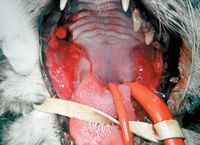Just Ask the Expert: Are corticosteroids helpful in cats with gingivostomatitis?
Dr. Daniel Carmichael helps a reader address this frustrating condition.
Dr. Carmichael welcomes dentistry questions from veterinarians and veterinary technicians.
Click here to submit your question, or send an e-mail to vm@advanstar.com with the subject line "Dentistry questions."
I have a feline patient with stomatitis. How many injections of methylprednisolone acetate should I give before extracting some or all of the teeth?

Dr. Daniel T. Carmichael
A. Feline gingivostomatitis can be a frustrating disease to treat. Affected cats may exhibit halitosis and signs of oral pain such as ptyalism, dysphagia, partial to complete anorexia (they often avoid the hard portions of the diet), and weight loss. Physical and oral examination can reveal gingivitis, stomatitis (especially in the caudal mouth), and, possibly, palatitis, glossitis, cheilitis, pharyngitis, and mandibular lymphadenopathy. Oral inflammation is often extensive, and affected tissues are typically ulcerated, edematous, hyperemic, and proliferative (Figure 1). Cats of any age can be affected.

1. Gingivitis, periodontitis, and severe inflammation of the oral mucosa in the caudal mouth (caudal mucositis) of a cat. This patient should undergo immediate diagnostic testing to identify underlying or concurrent diseases and to evaluate for potential anesthetic risks before extraction, which affords the best chance for cure.
The lesions associated with feline gingivostomatitis are the result of chronic inflammation (plasmacytes and lymphocytes) and are thought to be the result of a highly reactive immune system. The fact that most of these lesions resolve when the teeth are removed suggests involvement of an antigen that is intimately associated with the teeth (i.e. plaque bacteria).
Unfortunately, medical treatment options include either drugs with poor chances of success or drugs with serious side effects (e.g. high-dose corticosteroids). One drug that is often effective for a "short-term fix" is methylprednisolone acetate given at a dosage of 20 mg/cat subcutaneously every three weeks as needed. Long-term corticosteroid treatment is not ideal because cats can develop serious side effects, including diabetes and iatrogenic hyperadrenocorticism. Avoiding corticosteroids is especially important when treating cats with diabetes, feline leukemia virus infection, or feline immunodeficiency virus infection.
My experience has been that the best chance for long-term success in cats with gingivostomatitis is to perform the extractions as soon as gingivostomatitis is diagnosed so that corticosteroid treatment can be avoided. Extracting all teeth—or sometimes just the teeth behind the canines—has been shown to be effective in curing feline gingivostomatitis. Studies show that from 60% to 80% of feline gingivostomatitis patients treated with extraction of all (or most) teeth were either clinically cured or significantly improved.1 This procedure is labor-intensive and will not be successful if any root fragments are left behind. These cases are commonly referred to veterinary dental specialists.
Daniel T. Carmichael, DVM, DAVDC
Veterinary Medical Center
75 Sunrise Highway
West Islip, NY 11795
REFERENCE
1. Hennet P. Chronic gingivo-stomatitis in cats: long-term follow-up of 30 cases treated by dental extractions. J Vet Dent 1997;14:15-21.